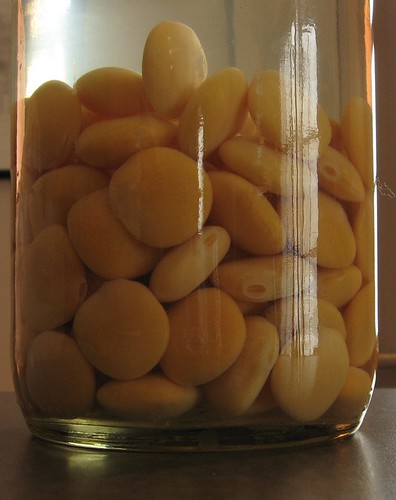2.28.2008
lupini beans
When I jump into the nightly dinner prep, I like to drink wine and snack. If there's a Cheeze It or a Goldfish Cracker nearby, it's gone and I can destroy my appetite. It's a bad habit. Something I like just as much for a quick snack is lupini beans. Odd comparison, but I love them. And, at 2/3 of a gram of fiber each, a nutritional snack too.
They are a pretty interesting food. Historically, they've been of a variety that has contained high concentrations of lupin alkaloids, e.g., sparteine (sorry, the link's a pdf) which is an oxytocic, can cause contraction of the uterus. Today, a different variety is common that contain much lower concentrations of lupin alkaloids.
However, when dry, they're still bitter. Really bitter. To make these beans good enough to snack on (popular beer snacks), they need to be hydrated. They can be purchased hydrated in brine, but they're a bit pricey. I scored a couple pounds of dry lupini at Carfagna's a month ago for about $3.30/lb ($4 a lb. delivered from Amazon). They can be soaked and hydrated - but it takes a long time. My first batch is finally done. I lost count of how many changes of water I've used. I took about 1/4 pound of them in a jar and covered them with water and about a tablespoon of salt. I dumped out this liquid and repeated the process every few days for about 2-3 weeks. Today, they are finally ready to eat. Yum. Better start hydrating another batch!
2.24.2008
Bring your baguette to work day
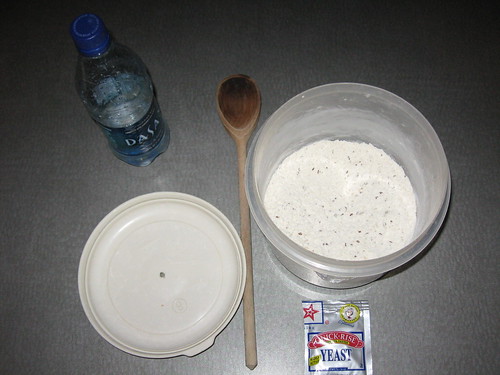
My baguette isn't just a good bread, it's a staple in our lives. The optimal surface area/volume ratio to get lots of crust and cool down properly in order to work on a weeknight for dinner.
Tomorrow, I'll be picking up the kid from daycare and I'd like to get a bread to the table for bread, salad and cheese night, so I'm packing my things and getting ready to prep the dough just before I launch out of work to daycare. In the bowl is 200 g unbleached white, 100 g of whole grain wheat (ground myself), 2T flax seeds, 1/4 C sunflower seeds and 1t salt. Tomorrow, I'll close my office door briefly and charge the yeast to my dedicated rubbermaid container then dump in my bottle containing 200 g water and 3 g olive oil, give it a stir until it clings in a shaggy mass and take it on the lam.
With the dough in process, I can relax, pick up Frankie, hang out a bit on the playground all the while my bread will be doing it's first rise. When I get in the door, I'll preheat the oven and pop the bread in within a half hour in the door and it should be out about 1 hour after getting in. In time for 6:00 dinner.
This will be a slightly different loaf. The quick baguette recipe with the coarse flour as 1/3 of the flour makeup and some seeds. I'll post a pic of the final loaf. Can't wait.
... the next day
Still some alterations to make due to the increased water absorption properties of the crushed wheat/coarse flour, but a nice loaf. We had a camembert with it as well as a salad with warm lentils over it.
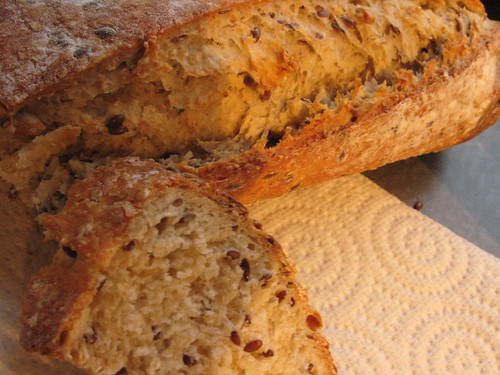
2.18.2008
2.17.2008
Stove Top "Boston Baked" Beans
Ever since my recent successful experience cooking old, old, dried chickpeas s-l-o-w-l-y, I've been thinking of bean tenderness and cooking time.
I love Boston Baked beans and decided to try cooking them the easiest method possible anticipating slow cooking would be key to the method. I wanted the prep to be as easy as possible, so I could do my Saturday crazy run of errands while the beans cooked. In a 3 1/2 quart saucepan, I tossed in a ham hock, dried, great northern beans (1/2 lb.), salt (1.5 t), brown sugar (2T), dry mustard (1T), pepper, cheapo generic bbq sauce (didn't have molasses, ca. 2T) and water to cover by a couple inches and gave a quick stir.
The mixture was heated to a boil and then placed on the smallest gas burner at the lowest setting half off the heat for the next 10 hours. It smelled lovely all day long. After the cooking, I pulled out and discarded the ham hock and gave a final taste. The consistency was a tad soupy, not thick but the flavor was nice. Not too sweet. I put the pot in the fridge overnight. Next morning, the beans had obviously continued cooking and simply aging. They thickened to a near perfect baked bean consistency. They are a tad more pale than most baked bean recipes because I didn't use molasses, but the taste is quite good. I'll be serving these with a small piece of ham and some bread this week. I'll put up a pic soon.
2.13.2008
Mark Bittman must be a parent
I was at Whetstone last night and stumbled on Mark Bittman's Quick and Easy Recipes.
The other night, while making Manjulo's aloo parathas I was amazed at the profound taste achieved when simple boiled potatoes were combined with some salt and fresh cilantro (the filling for the parathas). Wonderful, simple flavor combinations are all over Bittman's book. He rarely uses a recipe with more than several ingredients and emphasizes the technique more than the recipe.
It's speckled with nifty tricks. The caramelization achieved by searing a chuck roast is facilitated by a light rub of sugar, a sequential saute of sausage, mushrooms and kale followed by deglazing is said to build a depth of flavor so rich, the final liquid used need not even be a stock. I can't wait to jump into his fast cassoulet, apple crisp, the aforementioned sausage, kale and mushroom stew and especially the tuna au poive. Fast, good food. Nice catch for the local library!
2.11.2008
chapati
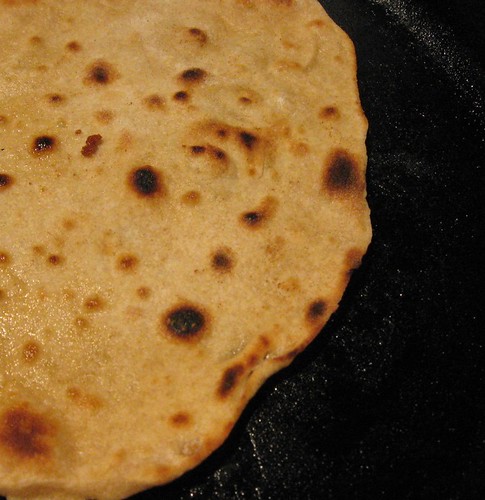
A few weeks ago, Mrs. DavesBeer made a queso blanco, which was pretty darn close to paneer (indistinguishable to me). From this lovely cheese, she made a perfect saag paneer. Tonight we had the best leftovers ever from this dish. But we were missing something. A good accompanying bread.
I have a problem with most whole wheat flour. The tanins in them give them a strong flavor that some characterize as bitter. Recent food processing methods disclosed in the food processing literature have focused on achieving lighter colored, milder tasting whole wheat flour to obtain a flour with better nutritional value and better flavor. Current processes use hydrogen peroxide for the bleaching. Past processes have used bromates which have been phased out over the past decade or so.
I don't usually like King Arthur Brand flours, but I think I've found an exception with their White Whole Wheat. It's not quite white, but off white in color and, in this recipe performed nicely. I'm looking forward to future applications with this flour since it's available all over the country.
I made a basic chapati dough from 1 cup whole wheat flour, 1/2 cup water, 1/2 t salt. The dough was kneaded briefly and cut into 6 pieces. These pieces were rounded and allowed to rest about 10 minutes. Each piece was dusted liberally with flour and rolled to about 8" in diameter. The thin discs rested a few minutes and were cooked in a barely oiled really frigging hot cast iron pan for about a minute on each side.
The star of the meal was the saag paneer, but the chapati were quite nice too. And, good kid food too (Frankie didn't like the spinach so much). Give 'em a try, great starch choice for a busy weeknight.
2.06.2008
What the hell is happening to me?
It all started when I put on my Ithaca Farmer's Market t-shirt this morning. Coincidentally, I've been somewhat obsessed lately by Heidi's caramelized tofu. She writes one of the most creative food blogs there is.
It all came together tonight when I made her dish with her suggestion of adding brown rice. A one-pot meal that is now a permanent part of our repertoire. Here's my recreation of her masterpiece (my photography isn't nearly as good).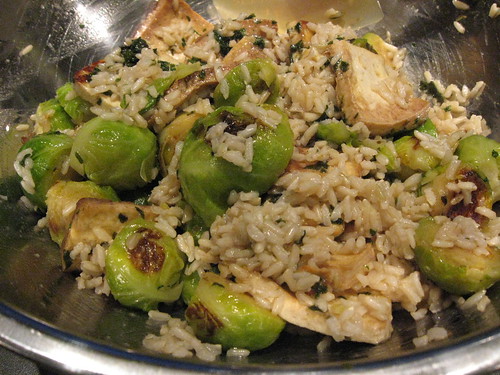
I also tried a new method for cooking the brussels sprouts. I usually roast them. Sometimes, however, they achieve a nicely caramelized outside, but are underdone inside.
Cook's Illustrated once described a method of cooking hash browns in a skillet; first the raw potatos were steamed covered and then browned with the cover removed. I applied this method to our brussels sprouts for this dish and they were superb. Tender on the inside and the exterior crisped nicely. Here they are.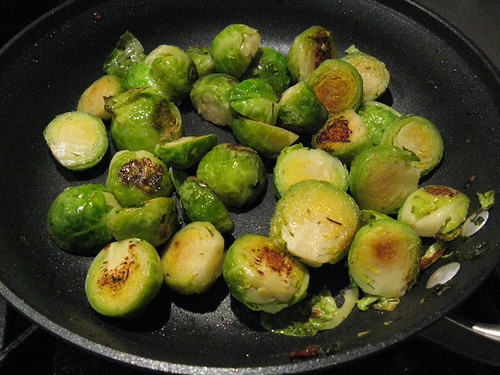
A good night for cooking - Thanks for the inspiration Heidi.
2.03.2008
Real Whole Wheat

I use whole wheat flour on occasion, but don't like it much. Has kind of a harsh flavor. The other day I got an idea. Last year I received a coffee burr grinder for xmas from my love. Works great for coffee, but what about grain? I added a couple tablespoons of hard winter wheat berries to clean out the coffee; a kind of dry cleaning. It worked well grinding the berries to flour and also cleaned out the coffee in the grinding mechanism.
I then proceeded to grind 150 grams of wheat berries which would make up approximately 1/3 the grain bill in today's kneadless boule. This time the boule was made from a sourdough starter I have. It's been around for about 6 years, a gift from a friend. I keep it in the fridge and refresh it a couple times before I use it.
I don't think I can make the entire grain bill from fresh ground whole wheat because:
1. It's too coarse a grind (even on the finest setting); this would cause the final dough to have an inadequate gluten network to get a good rise.
2. I have to find a reference, but flour requires a bit of aging prior to being useful for baking. About a decade ago, sodium bromate was used to accelerate this process, but was banned by huge committees who didn't understand the chemistry involved. They operated on the baseless assumption that all chemicals are deadly (the carbohydrates that makeup the dough are magic molecules, not chemicals). Off the soapbox and into the kitchen.
The dough was mixed from a cup of starter, water (350 g), salt (2t), unbleached white flour (350 g) and fresh ground wheat berries (150 g). It rose about 12 hours at room temp, was formed into a boule and tossed into a brotform to rise a couple hours. Then the proofed dough was carefully transferred to a preheated cast iron dutch oven and baked at 425-deg-F for an hour. Crappy result follows: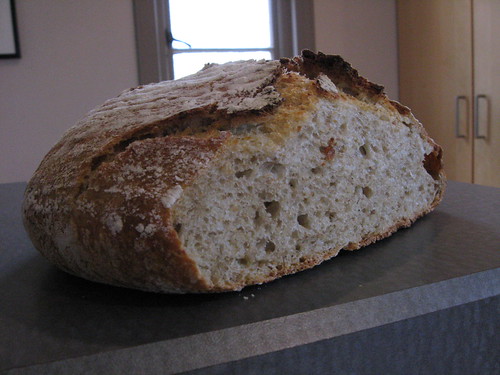
Ugh. Once in a while, I blow it and overproof. This loaf was rising kind of fast. Before placing the final proofed loaf in the oven, I zipped to Giant Eagle for PopTarts (I know) for the kid. When I returned, I realized I had lost my chance. I baked it anyway and I could tell it fell when it hit the pan. I posted it because this is the classic raindrop profile of a loaf that was over-risen prior to being baked. Once in a while, I like seeing these results. Keeps me in tune when the ideal time to bake is. Underproofed is always a better error. Oven spring can compensate for this error. Nothing can help an overproofed loaf.
Anyway, flavor was nice. Crumb just looks horrible.
Next... Aloo Parathas. Yum!
